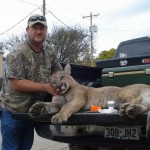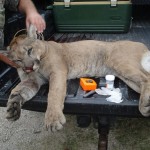This mountain lion was killed in early November 2009 about 6 miles south of Junction, Texas. The hunter was looking to harvest a white-tailed deer during Texas’ General Season when this cougar walked by. The photo was taken at Kimble Processing in Junction. Mountain lion sightings and kills have increased in recent years as the cats expand their range eastward again.
Mountain lions, also commonly referred to as cougars, pumas, or catamounts, have a large distribution across North and Central America. In fact, the Mountain lion has the widest distribution of any wild cat, from Canada to South America. Formerly distributed throughout North America, the Mountain lion is now found mostly in the remote areas of the western U.S., as well as western Canada and much of Mexico. A small lion population still exists in southern Florida, where the species is considered an endangered animal.
In Texas, the mountain lion is found throughout the Trans-Pecos, as well as the brushlands of south Texas and portions of the Hill Country, partiulary from Kerr and Kimble County westward. Mountain lion sighting and kill reports indicate that mountain lions now occur in more counties than they did 10 years ago and appear to be expanding their range into central Texas. Cougar sightings have been increasing in the southwest portions of the Hill Country, so keep an eye out if you live, visit, or hunt out there.


You were hunting deer and the mountain lion walked by, and you decided to shoot it instead?
A completely unnecessary kill. Rednecks and Guns do not mix!
Hunting this weekend in junction. This afternoon my girlfriend saw a large black cat to the left of the deer stand…. The deer seconds later were all spooked away. Could a mountain lion be black in color ? Or are there other large cats to watch out for in this area ?
People are killing to much animals.
If this going on, one day mountain lions became an endangered species..
Great Kill Unc…. I hate the story run through me head all the time as a memory of you!!!!
R.I.P. Toter Yates
I suspect there will be additional sightings in the near future.
Lion sightings are on the increase in the past 20 years in Central Texas. Especially in the major river bottom areas of Central and East Texas.